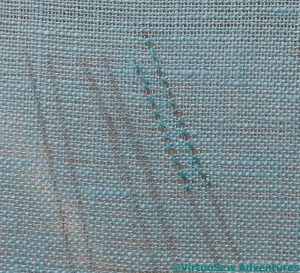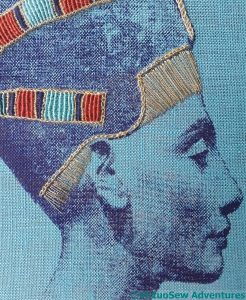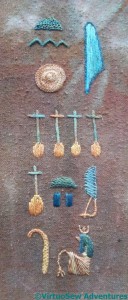Tag: Silk thread
The Head of Nefertiti – further details
I suddenly realised that I haven’t got any representations of the Aten in the panels. Considering that Akhenaten’s new, monotheistic devotion to the Aten actually created Amarna (Aketaten in his day), that is more than a little remiss of me. So the extra details I am planning for Nefertiti – shown here, drafted on tracing paper laid over the the print I didn’t use for stitching – begin to right that wrong.
I’ve drawn the rays of the Aten ending in little hands outstretched in blessing, as seen in many wall-carvings and paintings at Amarna. For some reason (research to be done…!) the hands nearest the noses of Nefertiti and Akhenaten often hold an ankh, so that is also included.
I’ve added in Nefertiti’s cartouche, although I think I may have drawn it too large for the design as a whole, and my own, which will include my initials in Morse Code, as this is a standalone companion piece.
I want the lines to be there, and yet not there, so I found some filament silk that I bought at Texere Yarns before they closed their store, and had a go with it, using reverse herringbone stitch, as I did for the contours of The Map of Amarna.
And it completely disappeared.
Oh dear!
So this is the next version, reverse chain stitch using a 2-into-1 twist. I’m much happier with that, although twisting the thread before I stitch with it does rather slow down the stitching part of it!
But still, here I am, stitching with hand-twisted thread, twisted by me. Never would fifteen-year-old me have believed I would be doing that!
If my Grandmama could see me now….
The Head of Nefertiti – continuing progress
So this is where we left the Head of Nefertiti. the polychrome bands and the gold edges of the headdress are done, and I have worked a section of necklace.
I keep flip-flopping between feeling that that section of necklace is just right, and feeling that it really isn’t enough at all. I like the sense of a delicate flash of colour barely surviving the years, but at the same time, there’s an inner glitter-girl that wants to see a bit more than that..
So, while I think a little more about the necklace question, I thought I’d make another attempt at the browband. This time it is simply straight stitches, in a slightly finer thread than the rest of the gold stitching. It’s not perfectly regular, but, again, the slight unevenness evokes the damage of the years.
And besides, by now, you must know that regularity of stitching is not my forte!
So, again, I find myself at a pause.
I’m happy with the browband, I think, definitely happy with the polychrome bands, and the gold trim.
However, I’m still not sure whether I’m happy with the necklace.
Since my thought is to quilt a pattern into the background, I had best be certain that I’m happy before I start attaching padding and picking patterns!
More progress on The Head of Nefertiti
Once I had finished the polychrome bands, I sat back and looked at them. Using the darker shades of the colours in the darker part of the print helps to tie it all together and wrap the bands around the headdress.
I had a moment or two of concern, then decided that I would not, after all, ruin everything if I continued to add the other elements of the design that I had planned. There is always a moment or two of fear, especially when an early section has gone well!
The original bust shows something that looks like a browband of gold, fairly plain and flat. I fished out a piece of gold kid, but although the photograph doesn’t show it very well, the kid is the wrong colour (too pale, and not yellow enough) for the gold thread, so I have to think of something else.
*Thinks hard*.
Meanwhile, I thought I would experiment with the necklace, or collar. My thought was that, rather than do the whole thing, I would do a small section of it, to make sure that I maintain the feeling of an embroidery, and not a portrait of a portrait.
What I have done here is to make radiating stitches of the gold thread, and then use the same whipped filling stitch I used on the polychrome bands, but alternating them so there is a hint of a gold net underlying the collar.
I like this, but maybe I do need to do an entire collar’s worth.
*Thinks hard*. Again.
The Head of Nefertiti – working with Silk
You will recall that I was rather underwhelmed by the effect of my first attempt at weaving the silk into the gold. Leaving the threads loosely packed to allow the gold to show through allows them to look untidy, and the colour is somehow a little flattened, not the rich, strong colour I wanted.
So I decided to work the whipped style of filling stitch instead. It creates a strong colour, something like a grosgrain ribbon, in fact.
I’m using primarily colours from the Mulberry Silks “Nefertiti” colour range (appropriate, don’t you think!), and I’m happy with the rusty red. The navy is actually a heavy perle type and I’m not sure where it came from. That works too.
The lightest colour, however, on the far right, is too fine. It produces too retiring an effect, and weakens the whole effect. So I tried one of the stranded silks from Thistle Threads (lower example, left), and wasn’t convinced by that, either.
This looks better. In fact the two light blue-greens are different, although that isn’t as clear in this photo as I might have liked. They aren’t as green as I would have liked, but I’m reasonably happy. If I decide to redo them, I may have to redo the whole thing, as the unpicking earlier on has left the Ladder Stitch a bit floppy.
Shadow Play
I decided, as I stared at the printing of this blocky pattern onto gauze, that I wanted to use the transparency of the gauze as part of the finished effect.
I don’t have a destination in mind for this piece which will give me a theme, so I decided that, in order to highlight that one quality, I would use a single thread (as it happened, a variegated silk), and design a fragment that would allow me to experiment with the effect of stitch cover and openness.
I leafed through books about pattern, saw nothing that gave me the combination I wanted, and then evolved the fragmentary organic sketch on the far left to give me the balance of line and form I was looking for. Incidentally, this is quite possibly the swiftest and shortest progression of any sketched design I’ve ever come up with!
It’s astonishingly difficult to trace a design onto a fabric which is essentially invisible, and still harder, I might add, to follow the lines when you have finally put them there!
I used Hungarian Braided Chain Stitch for the stem, satin stitch for the solid side of the leaf, and Jacobean trellis for the flower-head. Clearly that gives me a solid coverage, and a firm line; I was hoping that the Jacobean trellis might offer a sort of half-shade.
A qualified success, I’d say. The printed pattern doesn’t create a shadow, and the Jacobean trellis shadow isn’t a sort of half-depth.
But, my goodness, the shadow of the stem and the leaf work exactly as I hoped! The gauze itself almost disappears, leaving the printed pattern floating above the surface, and the leaf and flower thrown forward by their shadows.
The Head of Nefertiti, Embellished with Silk and Gold

Screenprint of the Head of Nefertiti
This is much the best print I’ve managed of Nefertiti, pressure, speed and amount of ink all working nicely, and very few really dark sections. What I want to do now is to highlight the coloured elements of the crown she wears – unique to her, apparently, no-one else in ancient Egypt has ever been depicted wearing it. I’ve got some gorgeous silk threads from Mulberry Silks which should do the job perfectly, but first they need a skeleton of gold. I had a lovely rummage in among the assorted wonders I’ve received from Thistle Threads (they have their own special box, of course), and after staring critically at the linen fabric, picked out the Special Tambour, and made a start.
 My idea is to create a framework of Ladder Stitch, and then add colour – as in the Tudor Rose project – using silk threads. Long term readers may recall that during the Tudor and Stuart Goldwork Masterclass, I had some trouble with Ladder stitch, so although I was fairly sure the idea would work, I sat down with some trepidation.
My idea is to create a framework of Ladder Stitch, and then add colour – as in the Tudor Rose project – using silk threads. Long term readers may recall that during the Tudor and Stuart Goldwork Masterclass, I had some trouble with Ladder stitch, so although I was fairly sure the idea would work, I sat down with some trepidation.
To be very pleasantly surprised. Something has happened in the intervening few years, and my ladder stitch wasn’t as trying as I expected, and moved fairly swiftly, too. I may yet decide to redo the stitches, because I re-tightened the fabric in the frame about halfway across, but that will depend upon how much better the second section looks when I have done it.
That’s a good start to a new project, isn’t it!
Well, At Last!
Rejoice with me!
I have finished the polychrome tent stitch on Eve In The Garden Of Eden!

It has taken what felt like forever (although the post describing the start is less than a year old, as it happens), because firstly, I have to do counted work in short bursts or it drives me up the wall, secondly it is very fine and required a magnifier, and thirdly – there’s a lot of it!
In fact, to be strictly accurate, I haven’t quite finished, but that is because the skip tent backgrounds for the cartouches reach under the trees, and I want to decide how leafy I want to make them before I do miles of tent stitch that may all be covered. But I feel as though I’ve reached a milestone, so please don’t rain on my parade!
Working on Nefertiti’s Cartouche – 2
After I’d finished the spiral trellis stitch circle, I had some doubts about it. Maybe it wasn’t strong enough, maybe the texture clouded the impression of the shape, maybe it even killed the colour. I’ve decided – with continuing reservations! – to keep it for now. I like the effect, and the knotted texture contrasts nicely with the long and short stitch beside it. If it can’t live with its companions when I’ve finished the piece, I will be in a better position to work out how to replace it.
The zigzag is about as simple as it could be – straight stitches, tightly whipped – and the half-circle, like the one in the lower section, is detached buttonhole stitch.
So far, so good.
All the individual hieroglyphs have been worked, and I think the colour balance has turned out pretty well.
However, cartouches have borders, and the border is giving me a raging headache!
I had thought of working the border in Plaited Braid Stitch, in a copper or gold, or maybe couching down a knitted ribbon. Maybe a border in some other stitch, in blue-green?
So far, every thread I’ve tried has either disappeared into the background, or made itself altogether too obtrusive. I can see myself staring balefully at it for weeks, so in the meantime I am going to tack guidelines for the eventual border (in silk, what else?) and hope that inspiration dawns…
























